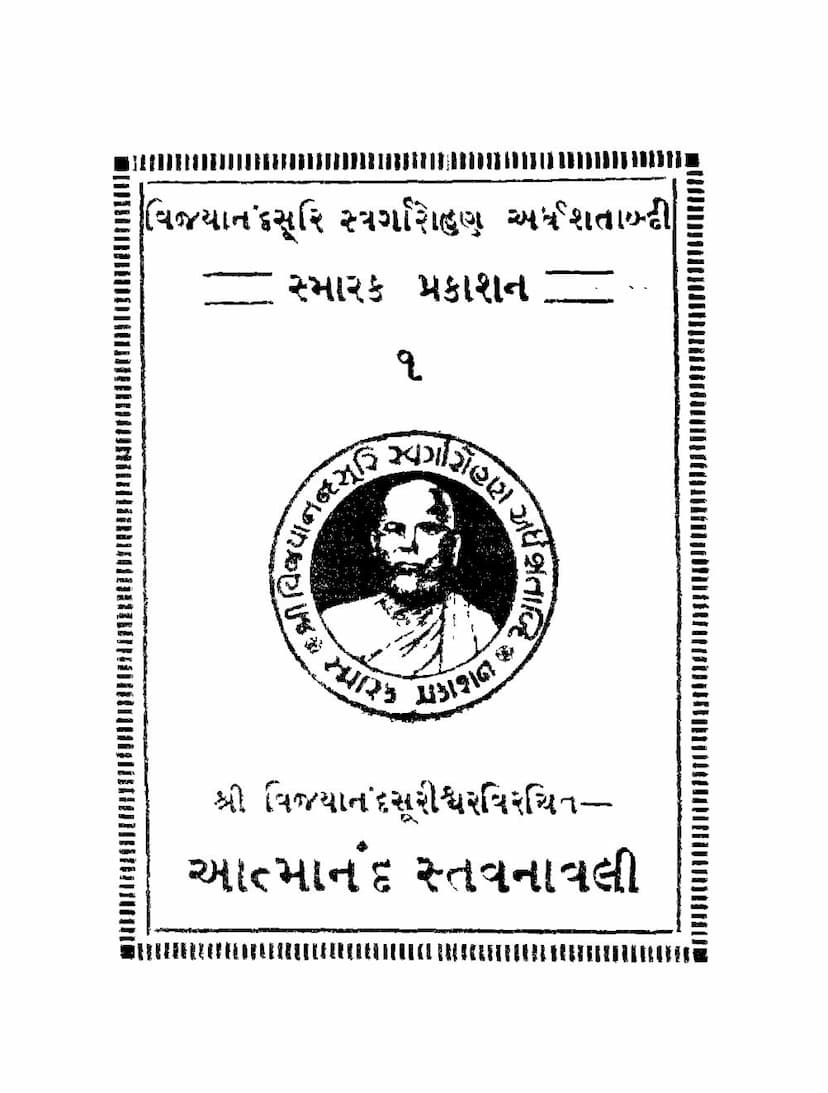Atmanand Stavanavali
Added to library: September 1, 2025

Summary
This is a comprehensive summary of the Jain text "Atmanand Stavanavali" by Vijayanandsuri, based on the provided pages:
Book Title: Atmanand Stavanavali Author: Vijayanandsuri (also referred to as Shri Atmaramji Maharaj) Publisher: Vijayanandsuri Smarak Trust Ahmedabad Part of a Series: Published as part of the Shri Labdhisurishwar Jain Granthmala [18].
Overall Purpose and Content:
"Atmanand Stavanavali" is a collection of devotional songs (stavan) and verses, primarily aimed at invoking the virtues and glory of the Tirthankaras (Jain spiritual leaders). The book is presented as a means to foster devotion, attain spiritual solace, and ultimately achieve liberation (moksha). The preface highlights that stanzas are important tools for spiritual upliftment, akin to cooling sandalwood for a soul scorched by worldly attachments and a boat to cross the ocean of existence.
Key Themes and Messages:
- Devotion (Bhakti): The central theme is devotion to the Jinavaras (Tirthankaras). The book emphasizes the importance of devotional practices, particularly "Bhav Puja" (worship with inner feeling), of which stanzas are a significant part.
- Praise of Tirthankara Qualities: The stanzas primarily focus on glorifying the inherent virtues, divine powers, and benevolent nature of the 24 Tirthankaras.
- Spiritual Guidance and Salvation: The text aims to guide the reader towards spiritual understanding and liberation from the cycle of birth and death (samsara). It addresses worldly suffering and offers the Tirthankaras as the path to overcome it.
- Accessibility of Jain Philosophy: The preface mentions that such stanzas are composed in vernacular languages to make profound spiritual concepts accessible to those who may not understand complex Sanskrit or Prakrit texts.
- Remembrance of the Guru: The publication of this work is particularly significant as it commemorates the 50th anniversary of the passing of Acharya Shrimad Vijayanandsurishwarji. It is intended as a tribute to his spiritual legacy and contributions to Jainism.
Structure of the Book:
The book is divided into two main sections:
- Khand 1: Stavan Chowvisi and Chhuta Stavan (Section 1: Collection of 24 Stanzas and Miscellaneous Stanzas): This section contains 24 stanzas, each dedicated to one of the Tirthankaras, starting from Adinath (Rushabhdev) and going up to Mahavir Swami. It also includes numerous other individual stanzas.
- Khand 2: Dwadash Bhavana and other Padas (Section 2: Twelve Reflections/Meditations and other Verses): This section delves into important Jain philosophical concepts and practices, including the "Dwadash Bhavanas" (Twelve Reflections), which are core meditations for spiritual progress. It also includes other devotional verses and padas.
Specific Content Highlighted (from the Index and Sample Pages):
- Tirthankara Stanzas: The first section features stanzas dedicated to each of the 24 Tirthankaras, such as "Pratham Jinesar Marudevinand" (for Adinath), "Ajit Tum Suniyo Chh Ajit Jinesh" (for Ajitnath), "Sambhavjin Sukhkarriya Lalna" (for Sambhavnath), and so on, up to Mahavir Swami.
- Dwadash Bhavanas: The second section includes verses on important reflections like:
- Anityabhavana (Impermanence): "Yauvan Dhan Sthir Nahi Rahana Re" (Youth and wealth do not remain).
- Asharanabhavana (Absence of Refuge): "Nij Swaroop Jaane Vin Chetan!" (Without knowing your true self, O consciousness, there is no refuge).
- Sansarabhavana (The cycle of Samsara): "Urjhayo Aatam Gyani Sansar Dukhdani" (O knowledgeable soul, you are entangled in the suffering of Samsara).
- Ekattva Bhavana (Solitude/Oneness): "Tum Ko Bhul Pare Bhamata Me" (Forgetting you, O consciousness, you wander lost in the world).
- Ashuchi Bhavana (Impurity): "Tanu Suchi Nahi Have Kale" (The body will not remain pure).
- Ashrav Bhavana (Influx of Karma): "Ashrav Ati Dukh Dana Re" (Ashrav brings great suffering).
- Samvar Bhavana (Stoppage of Karma): "Jinad Vach Sanvar Sun Re Sujnani" (Listen, O wise one, to Samvar from Jin's words).
- Nirjara Bhavana (Shedding of Karma): "Chetan Nirjara Bhavana Re" (O consciousness, meditate on Nirjara).
- Dharma Bhavana (Righteousness): "Chetanji Thane Dharm Ni Bhavana" (O consciousness, have the Bhavana of Dharma).
- Bodhi Durlabha Bhavana (Rarity of Enlightenment): "Anant Kal Se Badhidurlabh" (Enlightenment is rare since infinite time).
- Pilgrimage Sites (Tirthas): The text also includes stanzas related to significant Jain pilgrimage sites, such as:
- Vimalgiri: Mentioned frequently, associated with Adinath.
- Siddhachal: Several stanzas are dedicated to this important pilgrimage site.
- Ujjayantgiri (Girnar): Stanzas praising Neminath and the site.
- Sametshikhar: Stanzas dedicated to Parshvanath at this site.
- Hastinapur: Stanzas related to this site.
- Rampur and Shankheshwar: Mentioned in relation to specific Tirthankaras.
Commemoration:
The publication is particularly noteworthy as it serves as a "Swargarohan Ardhashatabdi Smarak Prakashan" (Commemorative Publication for the Half-Century of Ascension to Heaven). This marks the 50th anniversary of the passing of the revered Acharya Vijayanandsurishwarji. The effort behind this publication is attributed to the inspiration of Acharya Shrimad Vijaylabdhisurishwarji and the support of magnanimous individuals.
Editorial and Publishing Information:
- Catalog Link: https://jainqq.org/explore/011599/1
- First Edition: Published in 1947 (Vikram Samvat 2003).
- Printing: Done at Mahalaxmi Printing Press, Danapith, Bhavnagar.
- Editor/Compiler/Motivator: Pujya Upadhyayji Shri Jayantvijayji Ganivar is credited with inspiration for the contributors.
- Note on Research: The research and compilation for this edition are noted as having been done with great diligence, surpassing previous efforts.
In essence, "Atmanand Stavanavali" is a rich devotional compilation by a significant Jain Acharya, offering a pathway to spiritual understanding and liberation through the glorification of the Tirthankaras and the contemplation of key Jain philosophical principles, while also serving as a memorial to its esteemed author.